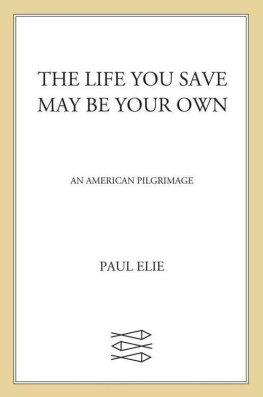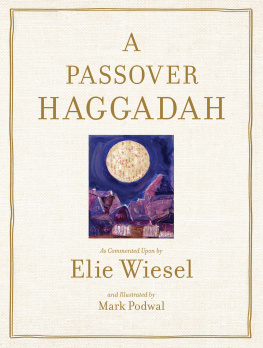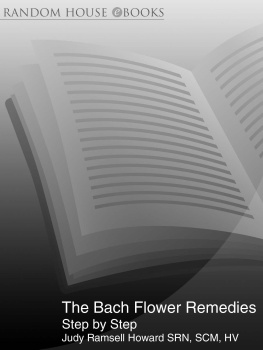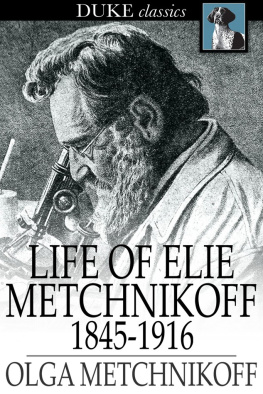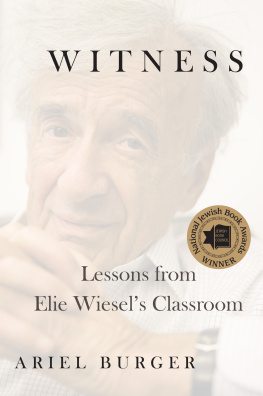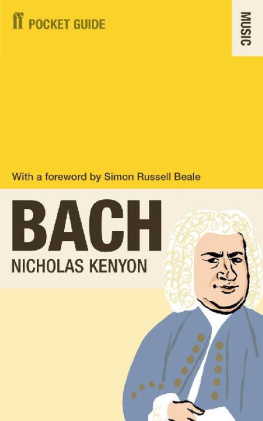Paul Elie - Reinventing Bach
Here you can read online Paul Elie - Reinventing Bach full text of the book (entire story) in english for free. Download pdf and epub, get meaning, cover and reviews about this ebook. publisher: MBI, genre: Detective and thriller. Description of the work, (preface) as well as reviews are available. Best literature library LitArk.com created for fans of good reading and offers a wide selection of genres:
Romance novel
Science fiction
Adventure
Detective
Science
History
Home and family
Prose
Art
Politics
Computer
Non-fiction
Religion
Business
Children
Humor
Choose a favorite category and find really read worthwhile books. Enjoy immersion in the world of imagination, feel the emotions of the characters or learn something new for yourself, make an fascinating discovery.
- Book:Reinventing Bach
- Author:
- Publisher:MBI
- Genre:
- Rating:5 / 5
- Favourites:Add to favourites
- Your mark:
- 100
- 1
- 2
- 3
- 4
- 5
Reinventing Bach: summary, description and annotation
We offer to read an annotation, description, summary or preface (depends on what the author of the book "Reinventing Bach" wrote himself). If you haven't found the necessary information about the book — write in the comments, we will try to find it.
Reinventing Bach — read online for free the complete book (whole text) full work
Below is the text of the book, divided by pages. System saving the place of the last page read, allows you to conveniently read the book "Reinventing Bach" online for free, without having to search again every time where you left off. Put a bookmark, and you can go to the page where you finished reading at any time.
Font size:
Interval:
Bookmark:

For my parents, Robert and Ellen Elie,
who filled the house with musicand still do
>>1>> Three hundred years later, you can inspect his manuscripts under glass, see the Bible he marked up while composing the Passions and the Mass in B Minor, walk the aisles of the churches where he made music. Eisenach, Arnstadt, Weimar, Leipzig: Bachs greatness is total and inviolable, and the holy sites associated with him are well maintained, the artifacts set out as if to counter the fact that it is hard to know what he was really like.
Look for a glass harmonica invented by Ben Franklin, a flute played by Frederick the Great, and Johann Sebastian Bachs cembalo. The mighty Wurlitzer is cranked up at noon on Saturdays. So says Lonely Planets Germany, so I go straight from the train station to the Musikinstrumenten-Museum-Berlin, in the Kulturforum, near the space-age hall where the Berlin Philharmonic plays. The place is more showroom than museum. The floor is comprehensively carpeted. Men in dark suits stand at attention doing nothing with great intensity. There are instruments as far as the eye can seepianos, electric organs, banjos small and large, a brass family, some bassoons racked like weapons, a tin drum.
I doubt there is another place on earth where so many assembled musical instruments are so quiet.
The harpsichords are upstairs. Most are obviously too recent to have been Bachs. But here is one tagged Cembalo, Gottfried Silbermann, um 1740a cherrywood harpsichord by the instrument maker who worked with Bach to renovate pipe organs all over Saxony. And over there, against a wall in a proverbial corner, is the thing itselfthe Bach cembalo.
I consider it the way an estate assessor would. It is a third smaller than a baby grand piano, low-slung, like a European compact car. The body is shel-lacked brown wood; there are knots in the curved sides, and the legs are stout and tapered, plain rather than carved. The lid is propped open, and if you look closely you can see that the instrument has no strings on it.
There are two manuals, or keyboards, one atop the other, each with five sets of twelve keys plus one more. Each is a negative of the piano keyboard: the big keys are black, the small ones white. There are scalloped pieces of wood at the two ends, like bookends made in shop class. Above the manuals, where Steinway or Yamaha usually goes, dark woods are inlaid in squares and diamonds, setting off an ivory inlay, a compass or cross.
I move in and marvel. The white keys are yellow. The black keys are worn down to a color akin to the skin of an eggplant. It is amazing to think that they were worn down by Bach himselfthat his fingers ranged across those keys over and over, playing the minuets children learn, the Well-Tempered Clavier, the fifth Brandenburg concerto with its exuberant cadenza, the Goldberg Variations.
Amazing: and yet something is lacking. I dont know the reason, but this cembalo actually owned and played by Bach himself seems inadequate to himdisconnected from him. There is a gap between the instrument and the music he made, and not just because, unstrung, it is unplayable.
It takes a stranger calling out spontaneously from another corner to make me realize why. Hey, lookthey have the synthesizer Pink Floyd used on Wish You Were Here... I follow his voice, and there it is: the EMS VCS3 Mark. II (London, 1972), a keyboard cased in walnut veneer and connected to a console with rows of brushed aluminum knobs.
This is the real thing: the actual instrument played on an album I have heard a hundred times.
The Bach cembalo is something else. Yes, Bach owned it, but its sound is conjectural. He played it, but we dont know what it sounded like when he played it, and we dont know him through its sound the way we know Pink Floyd through the sound of the gurgling synthesizerthis very oneon Shine On You Crazy Diamond. Bach is thought to have been the greatest keyboardist who ever lived, but none of us has ever heard him play. Only through othersother musicians, on other instruments, in other times and places, by other meanscan we know the music he made.
Thats all right: and, if you ask me, it is true to the music of Bach. Theres a portrait of him on the wall, but he is not here. He is in my pocket.
>>2>> This is a book about the music of Bach and the ways it has been reinvented in our time.
Sixty years ago Leonard Bernstein said that you had to go to certain churches or special little concerts if you wanted to hear Bach; and although he was stretching the point, he did have a point. Already things were changing, though. Already classical musicians were approaching the music of Bach with thrilling creativity and passion. At the same time, the music was making its way in society through film, television, and pop music. By the time Glenn Gould rerecorded the Goldberg Variations in 1981, his 1955 recording was a cultural touchstone, like Lolita or Annie Hall; and the Goldberg Variations themselves became touchstones, heard in the films The Silence of the Lambs and The English Patient, in an episode of The Sopranos, and in plenty of other places. On the first anniversary of the 9/11 attacks the music of Bach was at the World Trade Center site, played by Yo-Yo Ma; Yo-Yos friend Steve Jobs introduced the iPad to members of the press by playing Bach on iTunes. A couple of years later Bach was declared the greatest composer ever in a reader-participation exercise conducted by The New York Times.
Some would say that the music of Bach is in revival; and to say that is to enter into a conversation about Bach that has gone on for two hundred years.
From Martin Luther onward, religious revival has been a distinctive Protestant practice, rooted in the conviction that something vital is passing out of this world and can be saved only through ardent personal devotion and a return to the original sources of inspiration. Bach is the greatest of Protestant artists: born in Eisenach, where Luther was schooled, a true believer himself, a public servant of God as organist and music director at Lutheran churches, the composer of sacred works beyond numbering.
For many years it was an article of faith that his music had been saved by revival. In a commanding book about Bach, published in 1908, Albert Schweitzer told the story of a Bach revival in the nineteenth century as the background to his own argument that only a further revival of Bachs music and the human values associated with it could save European civilization as it hurtled toward world war.
Over time, a rival view formed around the evidence that Bachs music has thrived all alongthat it has been central to musical life in the West ever since he wrote it, taking different forms in different times and places.
Revival has a key role to play in the telling of Bachs story; but I think it is more precise and illuminating to say that the music of Bach has been reinvented in our time: by performers, and scholars, and scholar-performers, who have produced fresh truths about the music and how it was created. At the same time, the music has been reinvented through astonishing developments in recording technology, which have enabled musicians to approach the music in the inventive spirit of Bach himself.
>>3>> Bach was technologically the most advanced musician of his eraa technician of the sacred.
He served as organist, keyboardist, cantor, and music director, and his biographer Christoph Wolff sees these roles as stages in his lifes way as a learned musicianthe most learned of the age. He was especially learned about the pipe organ, the most complex mechanical apparatus of his time: he built, repaired, and renovated pipe organs, and put dozens of them to the test throughout Saxony and Thuringia.
Font size:
Interval:
Bookmark:
Similar books «Reinventing Bach»
Look at similar books to Reinventing Bach. We have selected literature similar in name and meaning in the hope of providing readers with more options to find new, interesting, not yet read works.
Discussion, reviews of the book Reinventing Bach and just readers' own opinions. Leave your comments, write what you think about the work, its meaning or the main characters. Specify what exactly you liked and what you didn't like, and why you think so.


